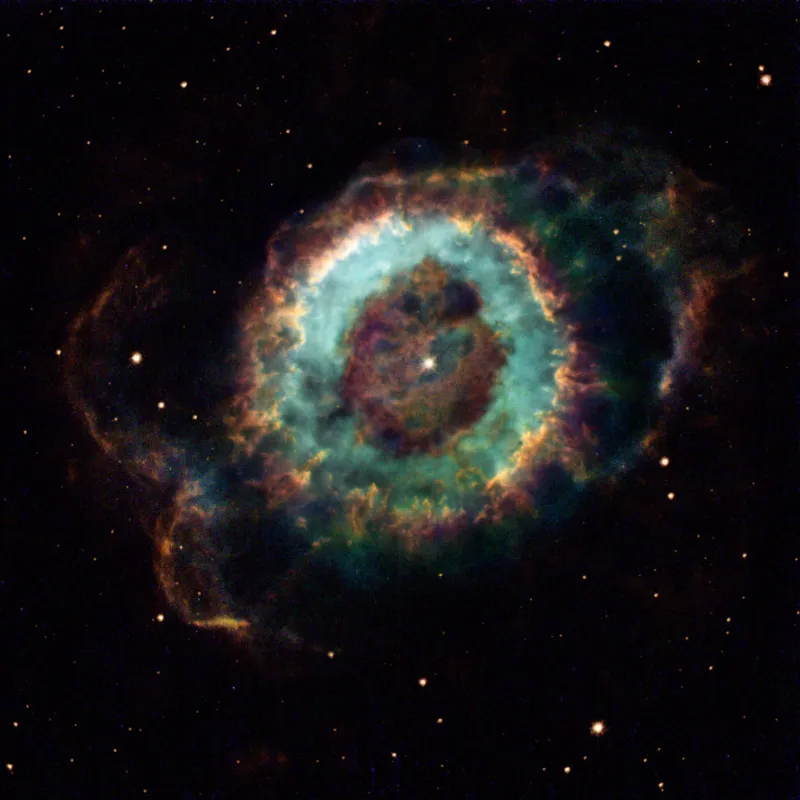Little Ghost Nebula (NGC 6369)

History
This planetary nebula was discovered by William Herschel on 21 May 1784 using his 20 feet long reflecting telescope with 18.7 inch mirror diameter. He cataloged it as IV 11 and noted: «Pretty bright, round, pretty well defined planetary disk, 30 or 40" diameter.» [464] Herschels son John later cataloged the nebula as h 1981. [466] William Parsons, the 3rd Earl of Rosse, observed the nebula twice in 1851 with his «Leviathan of Parsonstown», the six feet wide reflector and noticed its annular shape and a brighter nordern edge. [486] John L. E. Dreyer added it as NGC 6369 in his famous «New General Catalogue» of 1888 with the description «very remarkable annular planetary, pretty bright, small, round.» [313]
Physical Properties
NGC 6369 is a double-shell planetary nebula. A bright annular inner shell with faint bipolar extensions is surrounded by a filamentary envelope. The inner shell can be described as a barrel-like structure shape with polar bubble-like protrusions. It reveals evidence for H2 and strong polycyclic aromatic hydrocarbons emission from a photodissociative region (PDR) with molecular inclusions located outside the bright inner shell. High-resolution HST narrow-band images reveal a complicated excitation structure of the inner shell and a system of ‘cometary’ knots. The knotty appearance of the envelope, the lack of kinematical evidence for shell expansion and the apparent presence of emission from ionized material outside the PDR suggests that the envelope of NGC 6369 is not a real shell, but a flattened structure at its equatorial regions. Irregular knots and blobs of diffuse emission in low-excitation and molecular line emission have been discovered up to 80 arcsec from the central star. The filaments associated to the polar protrusions have spatial extents consistent with post-shock cooling phases. They likely represent regions of interaction of these structures with surrounding material. [489]
Simbad lists measured distances ranging from 1088 pc to 1139 pc. Magnitudes in different filters are: B 16.6, V 12.0, J 12.452 H 11.873, K 11.475. [145]
| Designations | PN G002.4+05.8: NGC 6369, PK 2+05.1, ARO 51, ESO 520- 03, He 2-232, My 101, Sa 2-207, VV 101, VV' 199, Wray 16- 277 |
| Right Ascension (J2000.0) | 17h 29m 21s |
| Declination (J2000.0) | -23° 45' 32" |
| Dimensions | 38." (optical) |
| Distance | 2.0 kpc |
| Radial Velocity | -101.0 ± 2.0 km/s |
| Expansion Velocity | 41.6 (O-III) km/s |
| C-Star Designations | AG82 243, CD -23 13397, GCRV 10105, HD 158269 |
| C-Star Magnitude | B: 16.99, V: 15.94 |
| C-Star Spectral Type | WC 4 |
| Discoverer | HERSCHEL 1784 |
Finder Chart
The planetary nebula NGC 6369 is located in the constellation Ophiuchus. The best observation time is in the months February to November.
Visual Observation
400 mm Aperture: In the 21 mm Ethos eyepiece (85x), the planetary nebula is clearly visible as a pale ring with a somewhat darker centre. An O-III filter makes the sky darker while the brightness of the PN remains the same, but does not reveal more details. At slightly higher magnification (16 mm Nagler, 112x) the ring structure is more clearly visible. At even higher magnification, the attraction of the sight fades. — 400 mm f/4.5 Taurus Dobsonian, Glaubenberg, 2. 8. 2022, 21:15, SQM 21.16, Bernd Nies
